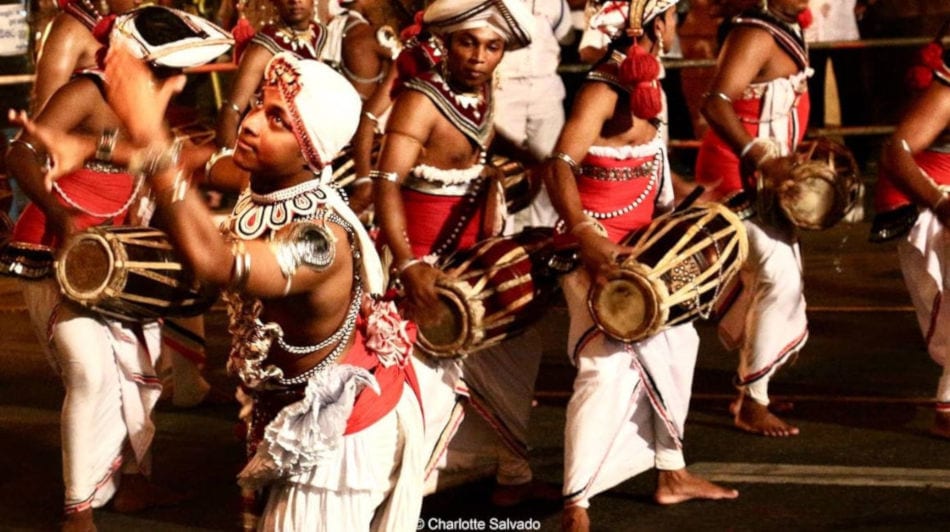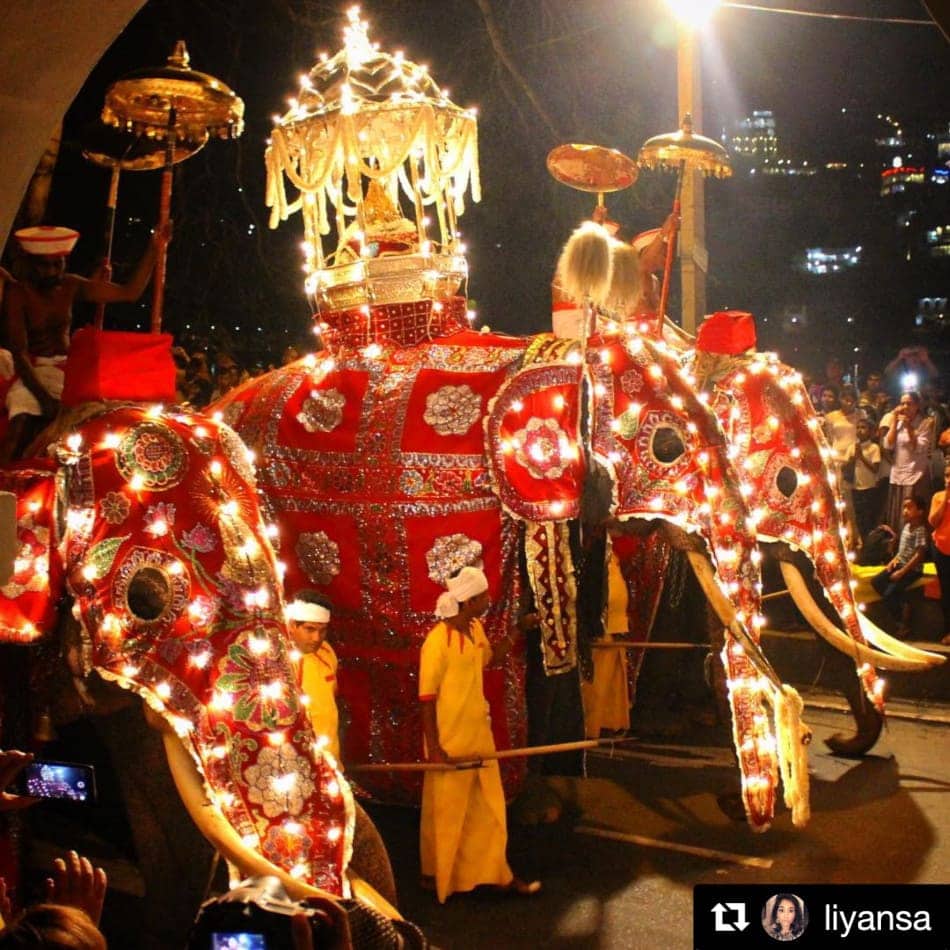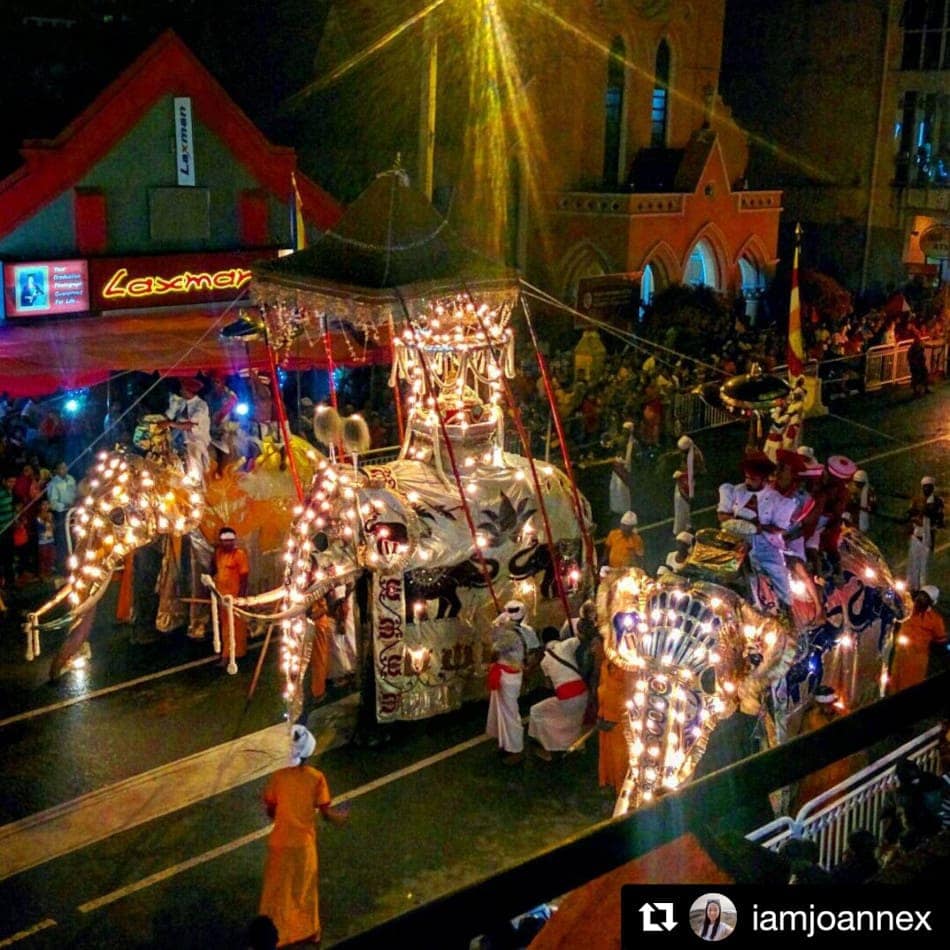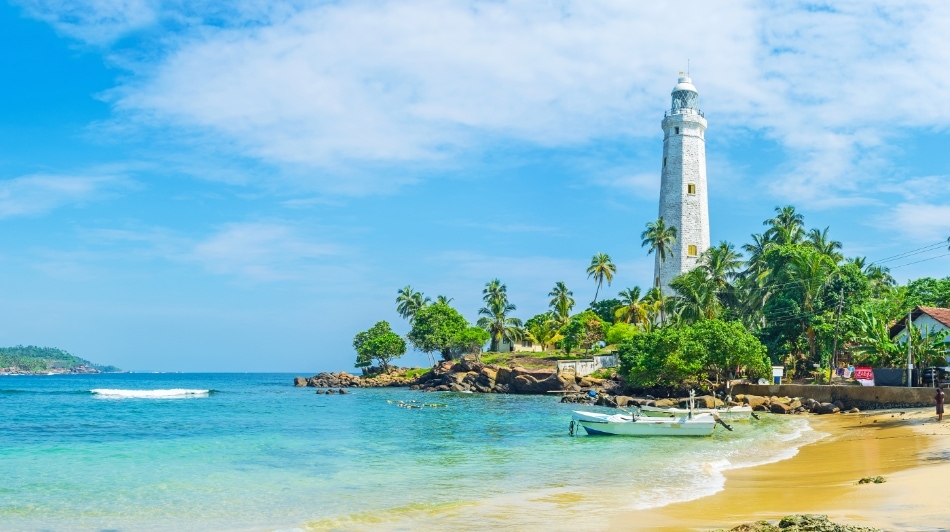Kandy Esala Perahera 2021 – The Festival of the Sacred Tooth
- buddhism
- kandy
- perahera

Kandyan dancers performing at the Esala Perahera
Photo credits:Charlotte Salvado
Every year, with the arrival of Summer, city of Kandy in heartland Sri Lanka also comes to life with preparations for the ‘Esala Perahera’, also known as ‘Dalada Perahera’ and ‘Kandy Perahera’. It is a grand procession held yearly since the 3rd Century B.C. Center of it all is the Temple of the Sacred Tooth Relic or ‘Dalada Maligawa’ which houses the relic of the sacred tooth of the Lord Buddha. During the Kandy Esala Perahera, the sacred tooth relic is carried around the streets of Kandy city to honour it as well as its four guardians, Gods Natha, Vishnu, Kataragama and Goddess Pattini.
Esala Perahera is considered one of the most beautiful of such processions in all of Asia and is held yearly to beseech blessings of the gods to obtain rain for the cultivation of crops and to enrich the lands of the kingdom. Procession itself signifies rain and different items in the procession subsequently brings life to the phenomena of rain, creating a spectacle of highest quality and grandeur to the onlookers.
History
The exact history of Kandy Perahera is a story lost in the misty layers of history. Numerous festivals have been held in honour of the sacred tooth relic since its arrival in the island. The sacred tooth relic was brought to Sri Lanka in the 3rd Century B.C. At the time, King Keerthi Sri Meghawarna was ruling in Anuradhapura Kingdom, Sri Lanka’s first Ancient Capital.
Esala Perahera, the pageant which is held today, first started during the reign of King Keerthi Sri Rajasinghe (1747 – 1781 A.D.) who ruled the Kandyan Kingdom, Sri Lanka’s last kingdom. When the country was invaded and colonized by the British and the kingdom fell in 1835, upon the request of the venerate Buddhist Theros of the time, a ‘Diyawadana Nilame’ – an office of chief lay custodian of The Temple of the Sacred Tooth Relic, was appointed to handle the administration of the sacred tooth relic. Up to date, Diyawadana Nilame holds the responsibility of organizing the perahera and it is held on dates selected by him, mostly in August or August.
Schedule of Kandy Perahera 2021
Kandy perahera 2021 is scheduled to be held from 13th of August to the 23rd of August. Following are the dates in which the perahera festivities of 2021 Kandy Perahera will be held.
| Event | Date |
|---|---|
| 13th of August 2021 | 01st Kumbal Perahera |
| 14th of August 2021 | 02nd Kumbal Perahera |
| 15th of August 2021 | 03rd Kumbal Perahera |
| 16th of August 2021 | 04th Kumbal Perahera |
| 17th of August 2021 | 05th Kumbal Perahera |
| 18th of August 2021 | 01st Randoli Perahera |
| 19th of August 2021 | 02nd Randoli Perahera |
| 20th of August 2021 | 03rd Randoli Perahera |
| 21st of August 2021 | 04th Randoli Perahera |
| 22nd of August 2021 | 05th Randoli Perahera – Final Maha Randoli Perahera |
| 23rd of August 2021 | Day Perahera |
Beginning of the Perahera
Beginning of the perahera period is marked with the ceremony of planting ‘kap’, where a sanctified young jak plant sprinkled with cinnamon scented water is planted in the premises of each of the four ‘devales’ during an auspicious time given by the astrologers. During the next five nights ‘Devale Peraheras’ take place within the Devale premises, where the priest of each Devale carries the pole every evening along with the flag and canopy bearers to the beat of music and drumming. They also carry the ‘Ran Avudha’ (Gold Armaments), the sacred insignia of the Gods.
Kumbal Perahera
Procession starts with the 1st Kumbal Perahera on the 6th night and it continues for five days. The 1st Kumbal perahera is led by the ‘Maligawa Perahera’ and the ‘Basnayaka Nilame’. It is joined by the other four devale peraheras. The 2nd to 5th processions are respectively from Natha, Vishnu, Kataragama and Pattini devales.
Randoli Perahera
After the 5 nights of Kumbal Peraheras, the Randoli Peraheras begin and continue for 5 nights. ‘Randoli’ refers to the palanquins on which the Queens of the ruling Kings traditionally travelled. During the days of the Kings, Kings and their chief Queens paraded in the procession. Later, the Queen was stopped from participating as it was considered improper. But, even now, a palanquin is taken as the last item of the procession as a honour to the Queen.
Maha Randoli Perahera / Final Randoli Perahera
‘Maha Randoli Perahera’ or the ‘Final Randoli Perahera’, which takes place on the 5th night of Randoli Peraheras (10th night overall) is the last procession and attracts thousands of visitors every year. It is the most beautiful, spectacular and grand of all the peraheras taking place and marks the climax of the Esala Perahera, only perahera in the world which is held for ten days.

Decorated elephants in procession
Photo credits:Sarah Lng
During the Maha Randoli Perahera, the sacred tooth relic is carried on a well-trained tusker elephant and both the elephant and casket in which the tooth is laid are splendidly decorated. Diyawadana Nilame also joins the pageant adding novel glamour to it. Have you ever wondered how many elephants take part in the Kandy Perahera? Then we have an approximate answer for you – It is the only Perahera in the world which is held with the participation of more than fifty elephants and tuskers adorned with ceremonial costumes, hundreds of drummers, dancers and singers.
Diya Kapeema
On the next morning after the Maha Randoli Perahera, four processions from the four devales head towards the steppingstones of the Mahaveli River in Getambe near Peradeniya. Then the chief priests of the four devales wade into the middle of the river and one of them marks a circle in the water with the point of a ‘golden sword’. Then they empty the ‘ran kendiya’ (golden ewer) which was filled at the exact same spot as last year and fills it with fresh water, which will be replaced the following year. This ritual is known as ‘diya kapeema’ (water cutting). Then they proceed back to the city and parade around the city 3 times (Day Perahera) before returning to the temple and the respective devales, marking the end of the annual Esala Perahera Festival in Sri Lanka.
Best places to watch and the main route plan
Hours before the Maha Randoli Perahera, almost all the road sides, balconies, roof tops, upstairs windows and even roofs are jam-packed with spectators, both local and foreign. Kandy Perahera starting time is normally after the sunset, at around 6.30 p.m. to 7.00 p.m. in the evening. Queens Hotel, Dalada Veediya, Yatinuwara Veediya some of the best places for you to watch the Esala Perahera. The Day Perahera can be viewed from the D. S. Senanayake Street and the King Street. Normally, the procession goes on for about 4 – 5 hours, continuously.

Three elephants in the Kandy Perahera
Photo credits:iamjoannex
Plan your visit to Sri Lanka during the Perahera season to witness this amazing festival of the sacred tooth, which attracts thousands of visitors from around the world.


